|
Welcome to Old Cardboard, the most complete reference resource for information about collecting vintage baseball cards and related memorabilia. More information about this eMagazine and its companion website is found at the bottom of this page.
Contents:
1. Updated Auction and Show Calendar
2. Controversy Continues Over Century-Old Stamp
3. Featured Sets: 1937 & 1938 Dixie Cup Lids and Premiums
4. Student Notebook Covers Gain Vintage Collector Interest
5. Latest Additions to the OldCardboard.com Website
6. News Briefs (A Digest of Recent Hobby Happenings)
1. Updated Auction and Show Calendar
The following is a summary of vintage card events coming up in the next 90 days. For the most current listings of additional vintage card shows and auctions, see the Key Events Calendar, accessible directly from the home page of the Old Cardboard website.
Have an event that needs to be on the OC Calendar?
Email editor@oldcardboard.com
| September 2020 |
| 17-19 | Long Beach, CA |
Long Beach Expo (see website for details). Canceled |
| 20 | Internet |
Birmingham Auctions (see website for details). |
| 20-21 | Phone/Internet |
Goldin Auctions (see website for details). |
| 23-24 | Phone/Internet |
Hake's Auctions (see website). |
| 24 | Phone/Internet |
Sterling Sports Auctions (see website for details). |
| 25-27 | King of Prussia, PA |
Philly Show (see website for details). Canceled |
| October 2020 |
| 3 | Dallas, TX |
Heritage Sports Auction (see website for details). |
| 4 | Phone/Internet |
Leland's Catalog Auction (see website for details). |
| 10 | Phone/Internet |
Memory Lane Auction (see website for details). |
| 14 | Phone/Internet |
Clean Sweep Auctions (see website for details). |
| 15 | Internet |
Bagger's Auctions (see website for details). |
| 17-18 | Hempstead, NY |
JP's Sports "Hofstra" Show (see website for details). Canceled |
| 22 | Phone/Internet |
Huggins & Scott Auctions (see website for details). |
| 23-25 | Chantilly, VA |
CSA Chantilly Show (see website for details). |
| 24 | Phone/Internet |
Goldin Auctions (see website for details). |
| 24 | Phone/Internet |
Small Traditions Auctions (see website for details). |
| 24 | Internet |
Brockelman Auctions (see website for details). |
| November 2020 |
| 1 | Internet |
Birmingham Auctions (see website for details). |
| 6-8 | Wilmington, MA |
Greater Boston Sports Collectors Show (website). Canceled |
| 12 | Phone/Internet |
Sterling Sports Auctions (see website for details). |
| 12 | Phone/Internet |
Huggins & Scott Auctions (see website for details). |
| 12-14 | Dallas, TX |
Heritage Sports Auction (see website for details). |
| 19 | Phone/Internet |
CollectAuctions.net Auction (see website for details). |
| 20-22 | Rosemont, IL |
Chicago Sports Spectacular Show (website). Canceled |
| 29 | Internet |
Birmingham Auctions (see website for details). |
| December 2020 |
| 4-6 | King of Prussia, PA |
Philly Show (see website for details). |
| 6 | Phone/Internet |
Robert Edward Auctions (see website for details). |
| 11 | Phone/Internet |
Leland's Catalog Auction (see website for details). |
| 12 | Phone/Internet |
Small Traditions Auctions (see website for details). |
| 12 | Phone/Internet |
SCP Auctions (see website for details). |
| 13 | Internet |
Birmingham Auctions (see website for details). |
| 12-16 | Atlantic City, NJ |
National Sports Collectors Conv. (website). Canceled |
| 15 | Austin, TX |
Old Cardboard eMagazine Release (Issue #176; website). |
| 30 | Phone/Internet |
Sterling Sports Auctions (see website for details). |
2. Controversy Continues Over Century-Old Stamp
The key stamp in this 1914 poster stamp set is an unnamed baseball player. Unfortunately, the lack of identity of the player on the stamp has been a source of controversy and confusion in the vintage hobby for decades. And while the confusion has been resolved for more than seven years, the controversy seems to continue to this day!
Details of the past controversy and current confusion are described in considerable detail below. But for a better perspective, a quick background profile about the set may be useful.
The Youth's Companion Poster Stamps set is a series of twelve stamps issued in 1914 by the Boston-based Perry Mason Company. The example illustrated above is the only baseball-themed stamp in the set. Others feature golf, tennis, rugby, hockey and other subjects related the production and circulation of the magazine.
All stamps are printed in full color and identified with "The Youth's Companion" tag line in the title on all stamps. They are perforated, measure about 1-7/8 by 2-1/2 inches and have gummed blank backs.
Poster Stamps, as they are generally called by collectors, were very popular in the early decades of the twentieth century. They were typically about twice the size of a postage stamp and acquired their name because most of them were designed to resemble scaled down versions of larger posters.
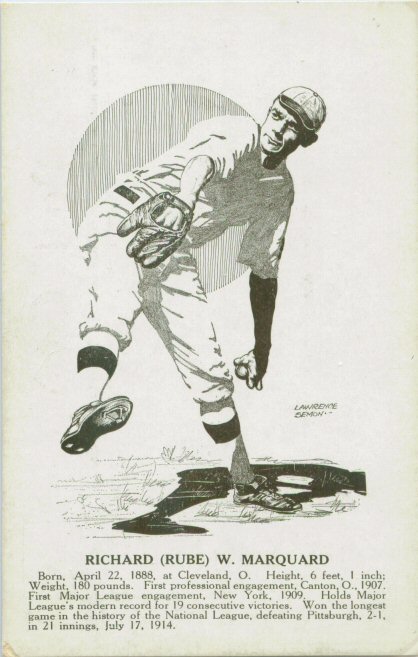
Rube Marquard
(Evening Sun Postcard Set) |
|
The confusion surrounding the Youth's Companion (often shortened to just Companion) baseball stamp stems from the absence of any player identification on the stamp.
For years, vintage collectors considered the player depicted on the stamp to be Babe Ruth, perhaps partly because the player on the stamp is in a left-handed pitching pose and partly because the uniform was said to (more or less) resemble that of the Boston Red Sox franchise of the period.
However, around 2013, it was discovered that the exact same pose found on the stamp was also used on a postcard in the New York Evening Sun postcard set. The detailed drawing on the postcard is very positively identified as that of Hall of Fame pitcher Rube Marquard (see postcard example at left). The long established year of publication for the postcards, by the way, is 1914.
The issue date for the Youth's Companion set has always been estimated in the vintage hobby as 1917, even after Marquard rather than Ruth was identified as the player on the stamp.

Ad from 11/12/1914 issue of
The Youth's Companion
(click to enlarge) |
|
However, as part of the research for this article, we discovered an ad that mentions the 12-card set in the November 11, 1914 issue of The Youth's Companion. The ad is reproduced in the graphic shown here (click on the image to enlarge).
Thus, we can now confirm that the poster stamp set was produced in 1914, if not earlier. This fact is now further evidence that the player on the stamp was not Ruth, as this was Ruth's first year in the Majors and he only played in five games. It would be several more years before Ruth would become a household name.
Further, a detailed search of more than 200 issues of Youth's Companion magazines distributed between 1913 and 1918 did not reveal any additional references to the poster stamp set produced by the magazine.
What a difference a player makes.
Given all of the above, it seems incredible today that some of the Marquard poster stamps continue to be sold on eBay and elsewhere with the claim that the subject on the card is Babe Ruth. The difference in perceived value can be eye-popping. The fact that some previously graded cards that label Ruth as the subject remain in the hobby and compounds the problem.
For example, consider these recent sales:
| |
Recent Youth's Companion Stamp Sales |
|
| Sale Date |
Seller |
Marquard
Identified? |
Card
Grade |
Sale
Price |
Link* |
| 11/11/2018 |
Heritage
Auctions |
YES |
PSA EX-MT 6 |
$108 |
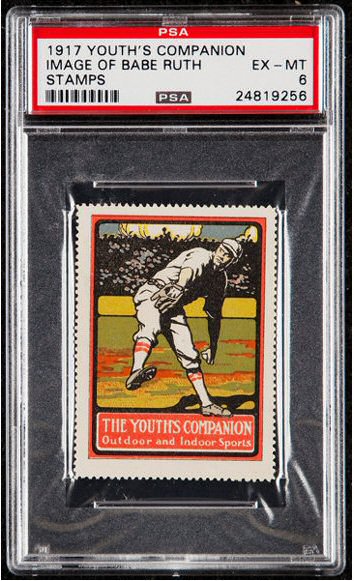 |
| 4/14/2019 |
Love of the Game
Auctions |
YES |
PSA NM-MT 8 |
$450 |
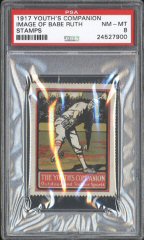 |
| 8/31/2020 |
eBay: Member
"Probstein123" |
NO |
PSA NM-MT 8 |
$1508 |
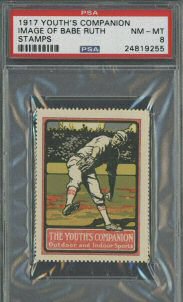 |
| Ongoing |
eBay: Member
"gidez32" |
NO |
PSA NM-MT 8 |
$6500 |
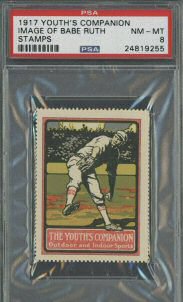 |
| * clicking on the linked image will take you to details of the original auction. |
As seen from these sales, pricing varies wildly and depends overwhelmingly on whether or not Marquard is correctly identified as the player on the stamp in the auction title or description.
First, kudos to Heritage Auctions and Love of the Game Auctions for disclosing Marquard as the true identity of the player in their auction write-ups.
Note that all four of the sales were for stamps graded by PSA with the subject incorrectly identified as Ruth. PSA has since corrected this mistake in their card labeling.
The last two sellers highlighted above both promoted the stamp as Ruth (one even suggests it is a Ruth rookie), without any mention of Marquard. It should also be noted that the 3rd and 4th auctions above were for the exact same stamp in the same graded slab, with the "ongoing" owner/seller asking a sizzling $6,500 in an eBay Buy-it-Now sale. Amusingly, both sellers even used the same scanned image to illustrate the stamp.
Out of a sense of responsibility to the vintage collecting hobby, we contacted the new owner/seller ("gidez32") via eBay in an attempt to clarify the issue. Our eBay text to seller:
"Greetings. Just want to make sure that you are aware that the subject of this stamp is Rube Marquard and definitely NOT Babe Ruth. I have lots of proof if you are interested. Please LMK if you have any questions. Thanks much, Lyman Hardeman"
The response read simply:
"...we will agree to disagree on this but I appreciate your opinion on it."
We'll let our readers make their own judgment.
Note: A Set Profile for the Youth's Companion Poster stamps has been added to the Old Cardboard website. In addition, although the 12-stamp set contains only one baseball player, a Set Checklist and Gallery of Stamps have been added for the full set.
The Youth's Companion magazine was established in 1827 and catered to America's youth and family. Its peak circulation was in the 1890s after it moved its posture from a children's magazine with a religious focus to a family magazine with a wider entertainment focus. Its contributing writers over the years included Harriet Beecher Stowe, Mark Twain, Emily Dickinson, Booker T. Washington, and Jack London.
The magazine was published by the Perry Mason Company of Boston (see the company headquarters building below). Interestingly, Erle Stanley Gardner (1889-1970), creator of the Perry Mason detective novel series, must have been an avid fan of the magazine during his youth. So much so that when Gardner launched his own writing career, he adopted the name "Perry Mason" as the central figure for his now famous detective novels.

Youth's Companion Building (1893 woodcut) |

Youth's Companion Building (2009 photo) |
The "Youth's Companion" Building is located at the corner of Columbus Ave. and Berkeley St.
in the Back Bay section of Boston. It is now on the National Register of Historic Places
|
The magazine is also credited with publishing for the first time a very early version of the United States Pledge of Allegiance.
The weekly Youth's Companion enjoyed a 102-year run. Its last issue was distributed in 1929 before merging with The American Boy.
 OC eMagazine Sponsor
OC eMagazine Sponsor |
3. Featured Sets: 1937 & 1938 Dixie Cup Lids and Premiums
The Dixie Cup Company never produced an ounce of ice cream. But the small paper cups that the company has manufactured by the millions have enabled the distribution of individual servings of ice cream for more than three quarters of a century.
Images of animals, U. S. Presidents and movie stars were used on the lid bottoms of individual cups of Dixie Cup ice cream beginning in 1930. It was not until 1937 and again in 1938, however, that sports stars were added. In each of those two years, only four baseball players were included in the 24-lid sets that until that time had been made up almost exclusively of movie stars.
The lids were made by the Dixie Cup Company (now a brand of Georgia Pacific) and distributed by a number of different ice cream makers to help promote their products.
Although their hobby set number is not often used by collectors, baseball Dixie Lids have been assigned the number F7 in the American Card Catalog. This ACC designation is also applied to the 8 x 10-inch premium cards that were offered by the company (see discussion of premiums below).
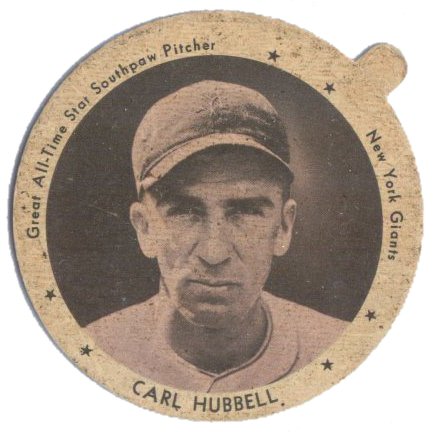
 The round lids are usually found in either 2-1/4 and 2-3/4 inch variations although lids of other sizes have been reported. The two "standard-sized" lids in 1937 for Carl Hubbell are compared here--both at approximate actual size.
The round lids are usually found in either 2-1/4 and 2-3/4 inch variations although lids of other sizes have been reported. The two "standard-sized" lids in 1937 for Carl Hubbell are compared here--both at approximate actual size.
The Dixie Lids in the 1937 and 1938 sets are both unnumbered.
Player images are printed on the underside (lid bottom) using either black or dark red ink (1937) or black ink with a blue or green tint (1938). A white border around the circumference of the lid contains the player's name, team, and a descriptive phrase (e.g., "heavy hitting left fielder, "record strike-out pitcher," etc.) to briefly characterize the player's primary strengths.
The four baseball players represented in the 1937 set are: Charlie Gehringer, Gabby Hartnett, Carl Hubbell, and Joe Medwick. Hubble was again featured in the 1938 set, along with Bob Feller, Jimmie Foxx, and Wally Moses. But while Hubble is found in both sets, the photos used for his cards are different.
1
9
3
7 |

Gehringer |
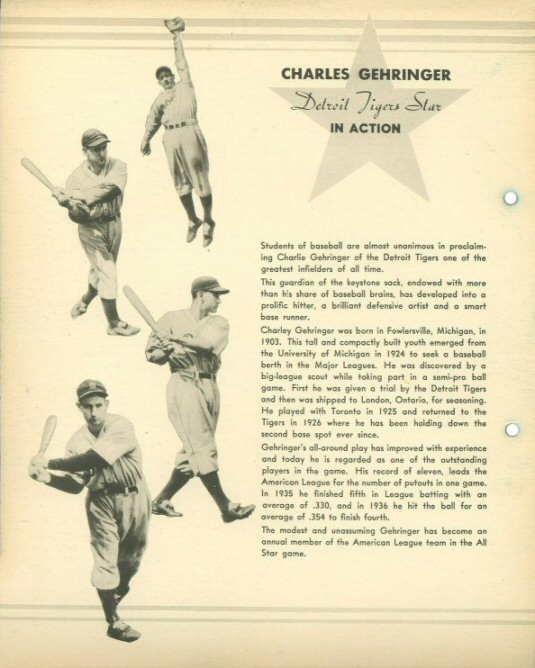
Gehringer Back |
1
9
3
8 |

Foxx |
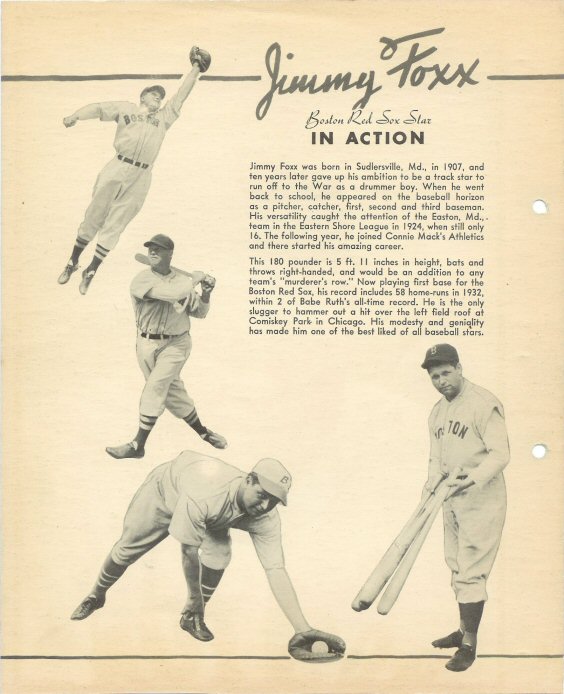
Foxx Back |
| Subtle Differences Mark the 1937 & 1938 Dixie Premium Designs |
In addition to the lids, premium albums were also issued by the Dixie company. The 8 by 10-inch premiums feature the same four baseball subjects (but not always based on the same photo) found on the lids.
While the premiums for each year are similar in appearance, there are small differences in design that can be used to readily identify the cards in each set. In 1937, the player photo was printed in a borderless format with a vertical dark green panel at left.
The player images in the 1938 premiums are framed inside a black frameline. The vertical green panel at left is also printed in a lighter shade of green.
In both years, the player is identified in the vertical panel at left. In 1937, player names are printed in yellow while in 1938, names are printed in black ink.
Two holes are also factory punched near the left edge of the cards to facilitate binding the album with a "string" tie.
The premium backs are printed with action photos of the subject along with a relatively detailed career overview. As seen in the illustrations, the layouts for each year are very similar. The key distinguishing difference is in the titling at the top of the cards.
Dixie Lid Sponsors
While most collectors focus on the lids or the premium albums described above, many are also intrigued by the lid backs (lid tops, or sponsor side).
Altogether, hundreds of brands have been promoted and distributed in the now-famous Dixie Cup containers. The card backs (lid tops) shown here carry the promotions for a few of the brands active in 1937-38. When shown as part of a group, they make a colorful display, as illustrated here.
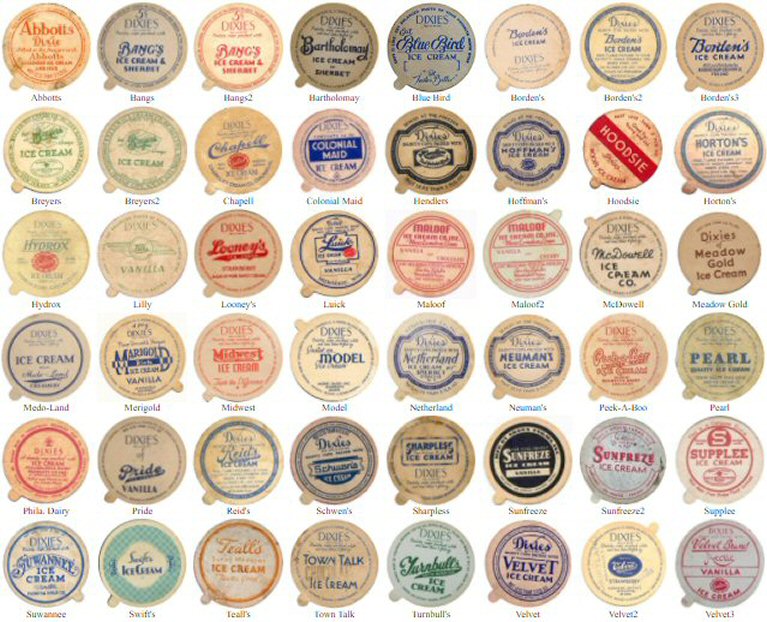 |
Four Dozen Different Lids. The above shows examples of 48 different Dixie Lids representing ice
cream brands of many vendors. For an enlarged view of each individual lid, as well as additional
brands from an expanding gallery, go to the Dixie Brands Gallery on the Old Cardboard website. |
A Set Profile, Checklist (baseball only) and Gallery of Cards (baseball only) for the 1937 and 1938 Dixie Lids is provided on the Old Cardboard website.
In addition, a Gallery of Premiums and a Gallery of Dixie Brands (lid tops) has been posted to the Old Cardboard website. Note: the Gallery of Dixie Lid Brands is incomplete and will continue to expand. We welcome all input from our readers and will update the gallery as new card images become available.
Thanks to OC Subscriber and Dixie Lid collector Dan Good for his review and contributions to this article.
4. Student Notebook Covers Gain Vintage Collector Interest
Very popular in the early decades of the twentieth century, these notebooks were used mostly for children's school work. They have now become valued collectibles, either as intact bound tablets or as covers that have been removed from the original pages that they contained.
Referred to as Composition Notebooks, or Pencil Tablets, the notebooks came in a wide variety of designs and sizes. Of these, some two dozen designs (sets) are now known that feature a baseball theme. Some are found as a stand-alone design, but many are part of multi-subject series. None of them are cataloged in the American Card Catalog.
Most of the tablets measure roughly between 6 by 9 inches and 8 by 10 inches and contain 40-50 ruled pages. They were bound either on the top or left edge.
Interestingly, many of the notebooks remain intact today with student's math or compositions still recorded. Of these, some are dated, helping to narrow the range of dates in which the tablets were distributed and used.
The twenty notebook examples below are among the sets more frequently encountered today. Together, they provide a representative cross-section of baseball-themed notebook sets.
A somewhat larger "Gallery of Covers" (similar to the one displayed above) has been added to the Old Cardboard website. Just select any cover of interest to see more details. For most of these sets, Player Checklists and Set Galleries are also provided.
In addition to the above twenty notebook series, we have extracted a few more from the Old Cardboard image files. Ten of these are displayed below. Although there is insufficient information now to develop more detailed Profiles, Checklists and Galleries, we will continue to expand the Notebook Covers section of the Old Cardboard website as more data becomes available.
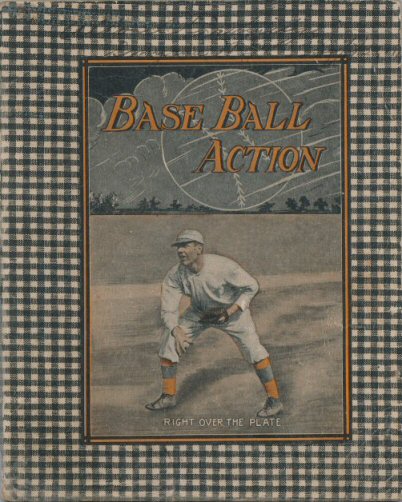
Baseball Action |
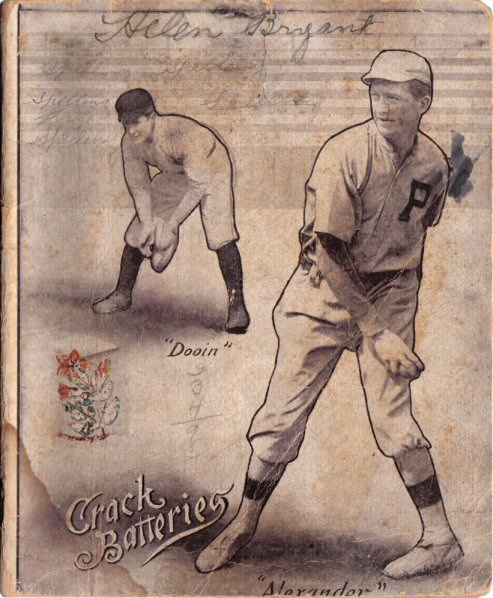
Crack Batteries |
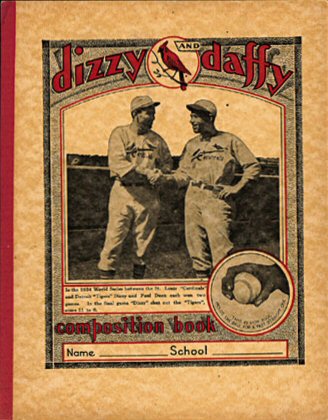
Dizzy & Daffy Dean |
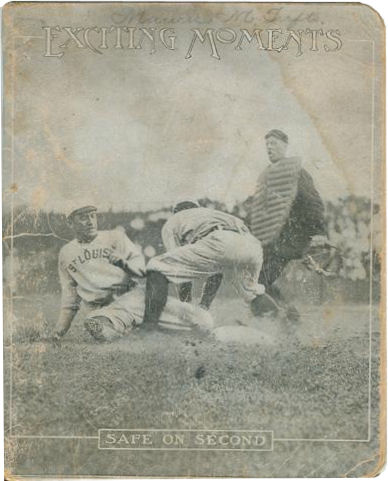
Exciting Moments |
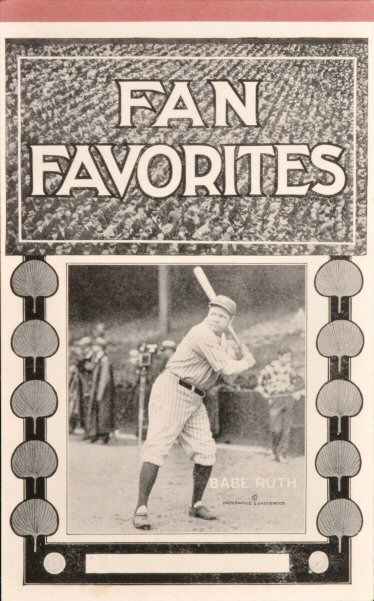
Fan Favorites |
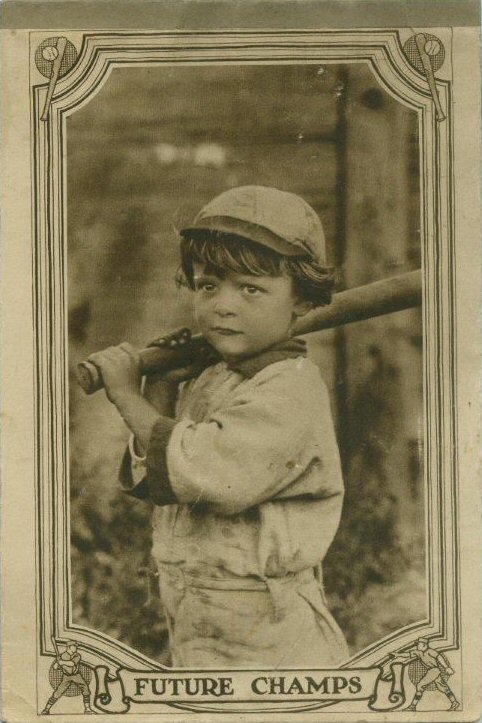
Future Champs |
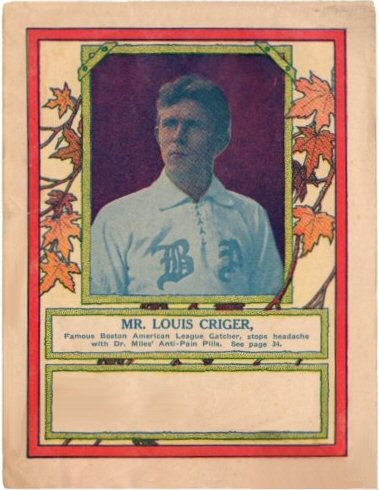
Green/Red Frames |
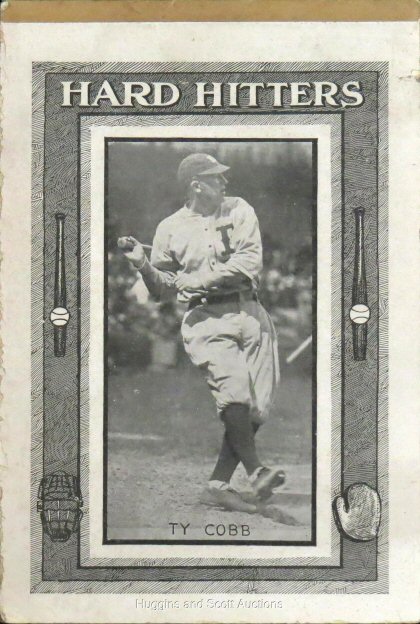
Hard Hitters |
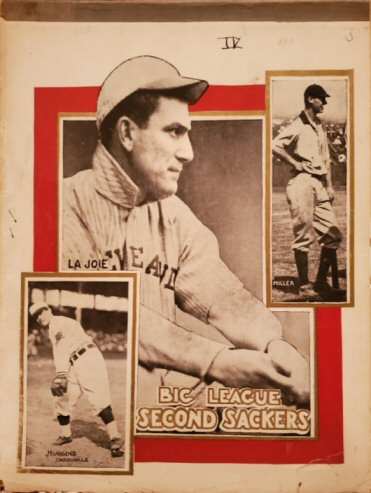
Second Sackers |
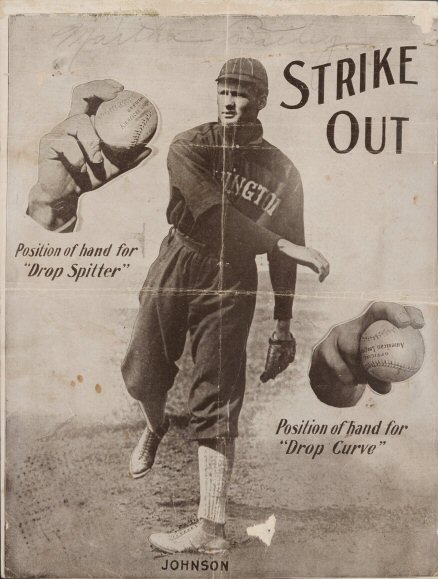
Strike Out |
Note to Readers: If you can add to the information provided here and on the Notebook Cover Profile pages of the OC website, please do so. We will update the website accordingly. We (and your fellow readers) appreciate your interest and your input.
5. Recent Additions to the OldCardboard.com Website
We are continually expanding the Old Cardboard website with more set profiles, checklists and card galleries. Recent (past 30-40 days) additions include:
Set Profiles have been added for:
American Card Sets. Profiles for a dozen or more Notebook Covers have been added, including:
"Base Ball Star" Notebook Covers
1911 World Champions (Athletics)
1920-21 Favorites of the Diamond Notebook Covers
Circa 1917 Play Ball 1 Notebook Covers
"1910 Red Frameline Notebooks
1910 "The Rivals" Notebook Covers
1910 "Set of Five" Notebook Covers
1914 Notebook "Set of 12"
Circa 1924 Stars of the Diamond Notebooks
1911 Yellow Woodgrain Notebook Covers
In addition, a GALLERY OF COVERS has been added for the Notebook Covers section.
Japanese Cards. Dozens of Japanese card sets have been added to the OC website since the distribution of our June eMagazine (Issue #174). These are all organized and cataloged on the Japanese GALLERY OF SETS page.
Set Checklists have been added for:
"Base Ball Star" Notebook Covers
1920-21 Favorites of the Diamond Notebook Covers
Circa 1917 Play Ball 1 Notebook Covers
"1910 Red Frameline Notebooks
1910 "The Rivals" Notebook Covers
1910 "Set of Five" Notebook Covers
1914 Notebook "Set of 12"
Circa 1924 Stars of the Diamond Notebooks
1911 Yellow Woodgrain Notebook Covers
1952 F219-6 Royal Desserts Premiums
Set Galleries have been added for:
"Base Ball Star" Notebook Covers
1920-21 Favorites of the Diamond Notebook Covers
Circa 1917 Play Ball 1 Notebook Covers
"1910 Red Frameline Notebooks
1910 "The Rivals" Notebook Covers
1910 "Set of Five" Notebook Covers
1914 Notebook "Set of 12"
Circa 1924 Stars of the Diamond Notebooks
1911 Yellow Woodgrain Notebook Covers
1937/38 F7 Dixie Lid Premiums
1937/38 F7 Dixie Lid Brands
1952 F219-6 Royal Desserts Premiums
Updating the website with checklists and full set galleries for additional vintage sets is an ongoing project, so check back often to check out the latest additions. There are now many thousands of card images on the website and the list continues to grow every month. We welcome and encourage feedback with checklist additions, images of cards missing from our galleries, error corrections and suggestions. Please send all feedback to editor@oldcardboard.com.
Beyond the above pages recently added to the Old Cardboard website, we continue to expand and refine our eBay Custom Search Links to make finding vintage baseball cards on eBay easier than ever. The results of these searches are continuously changing, so check back often to find the most recent eBay listings. Samples of a few of these custom searches are provided below. Hundreds more are provided on the Set Profile pages throughout the Old Cardboard website.
6. News Briefs (A Digest of Recent Hobby Happenings)
Most Card Shows Canceled for 2020: As with the rest of the world's population, vintage collectors are looking forward to seeing the year 2020 in the rear view mirror. A glance at the Old Cardboard Calendar of Events for the balance of the year reveals half a dozen or so card show cancellations due to the Covid-19 virus. And those are only the largest shows. Fortunately, with a little luck, it looks like we can all anticipate a much better 2021.
Lyman and Brett Hardeman
Old Cardboard, LLC.
Old Cardboard LLC. was established in December 2003 to help bring information on vintage baseball card collecting to the hobbyist. Produced by collectors for collectors, this comprehensive resource consists of three components: (1) Old Cardboard Magazine (currently on hold after printing 34 Issues), (2) a companion website at www.oldcardboard.com and (3) this eMagazine. The Old Cardboard website contains well over 1000 pages of descriptive reference information for baseball card sets produced fifty years ago or longer. Each of the set summaries has a direct set-specific link to  auctions and a similar link to auctions and a similar link to  's powerful search engine for further research. The website also includes a Show and Auction Calendar, an eBay Top 50 Vintage Sellers List, and much more. As a result, the Old Cardboard website makes a great "Alt-tab" companion for vintage card shoppers and researchers. Each Old Cardboard eMagazine provides three or four articles about vintage baseball card sets or related memorabilia, current hobby news, upcoming shows and auctions, and updates to the website. It is published quarterly around the middle of the last month of each quarter. For a FREE subscription to the eMagazine, please visit the website at www.oldcardboard.com. If you find this information resource helpful, please tell your friends. We need your support and your feedback. Thank you. 's powerful search engine for further research. The website also includes a Show and Auction Calendar, an eBay Top 50 Vintage Sellers List, and much more. As a result, the Old Cardboard website makes a great "Alt-tab" companion for vintage card shoppers and researchers. Each Old Cardboard eMagazine provides three or four articles about vintage baseball card sets or related memorabilia, current hobby news, upcoming shows and auctions, and updates to the website. It is published quarterly around the middle of the last month of each quarter. For a FREE subscription to the eMagazine, please visit the website at www.oldcardboard.com. If you find this information resource helpful, please tell your friends. We need your support and your feedback. Thank you.
|
|
|
Old Cardboard sponsors make up the Who's Who of the vintage card hobby.
They're Awesome!
Note To Our Readers:
The support of the above sponsors enables us to continue to expand Old Cardboard's online info resources. We appreciate their support and hope
that you do also.
|
|

